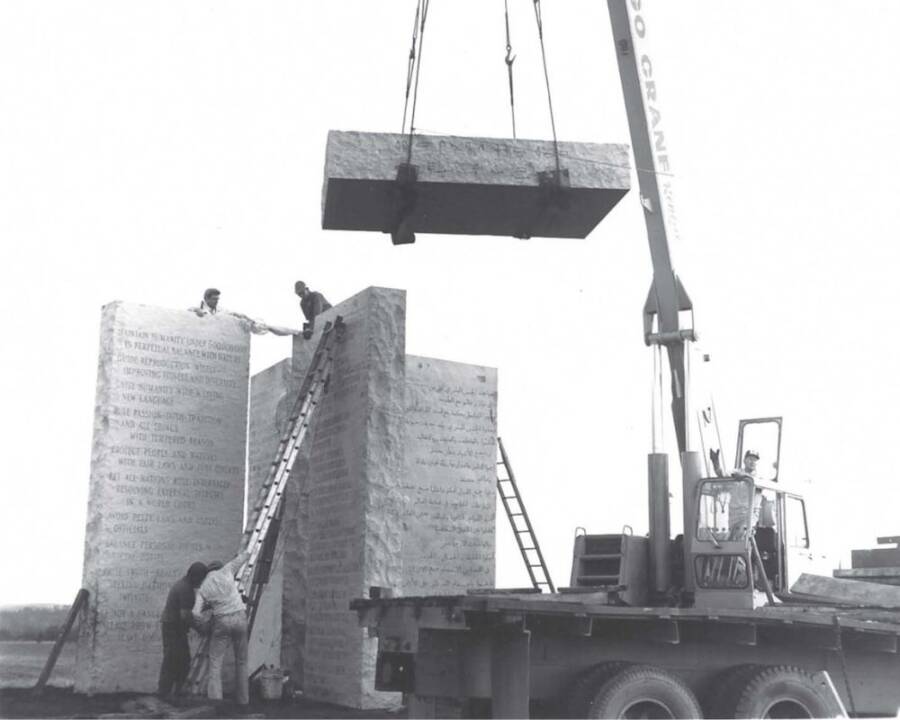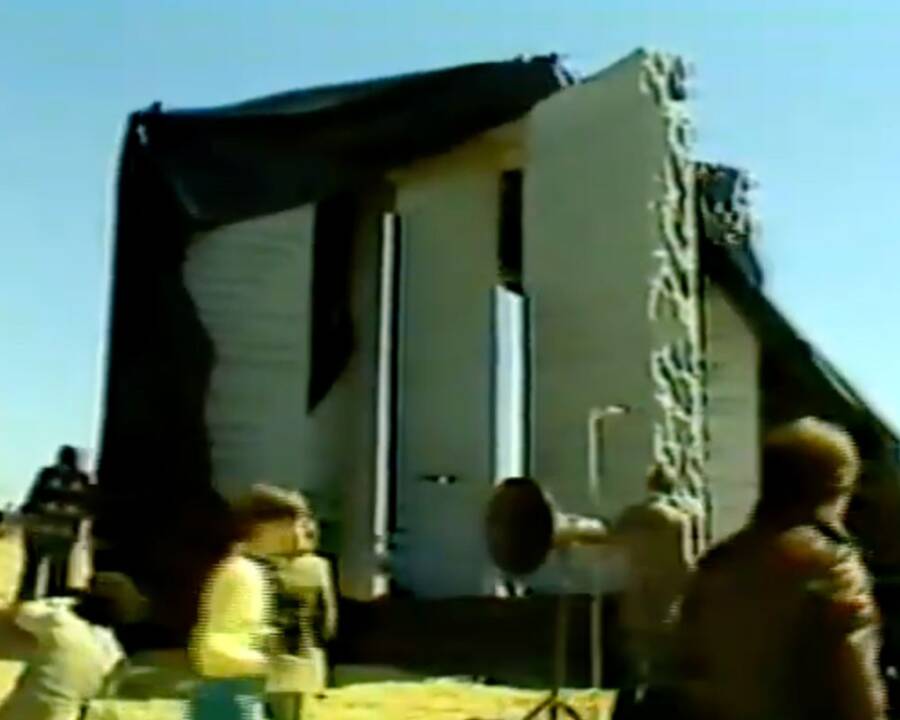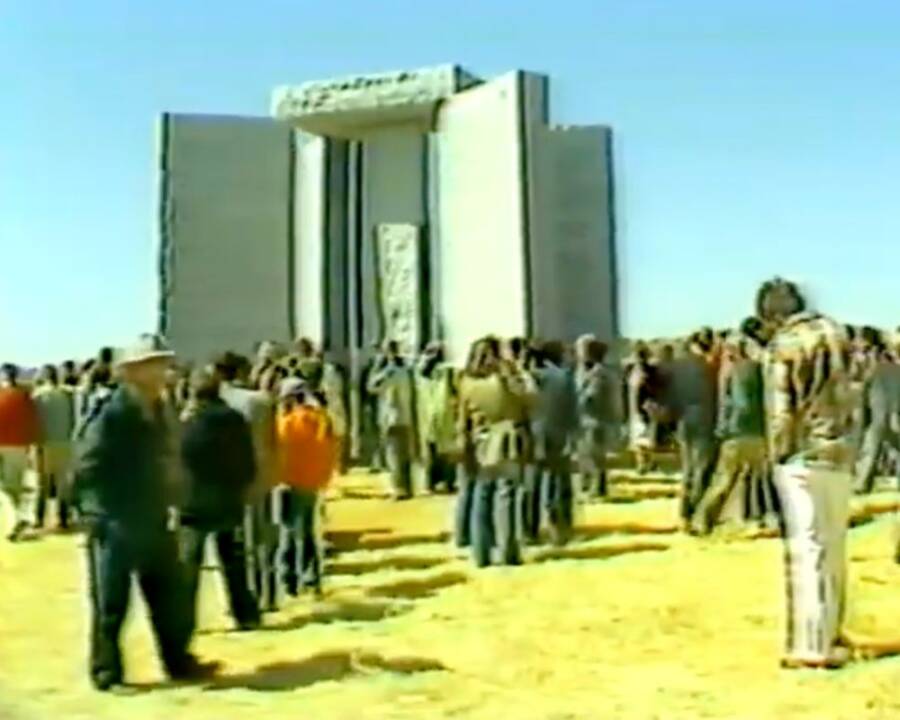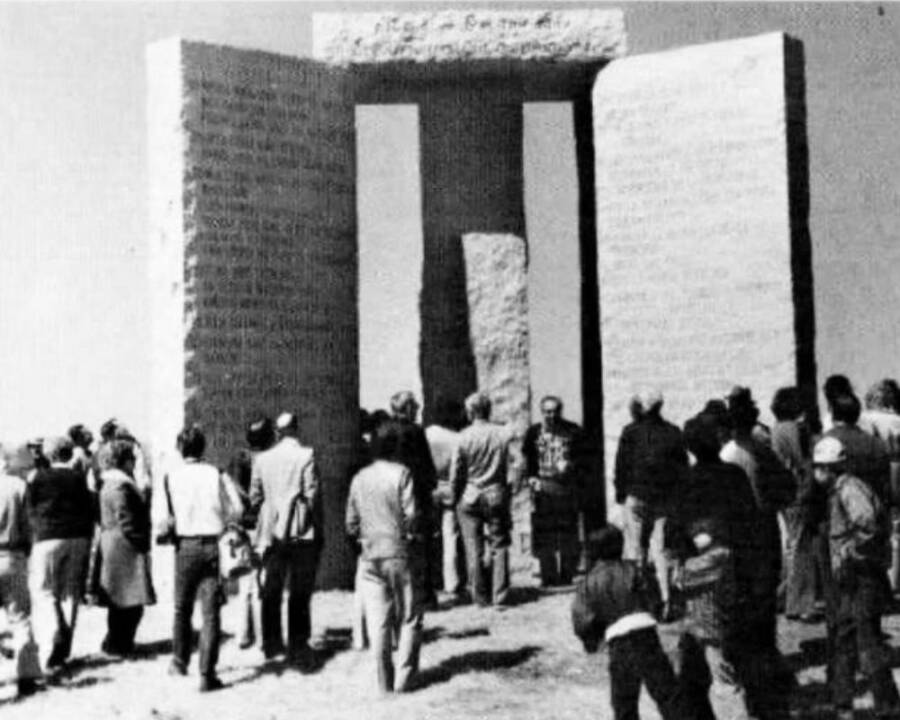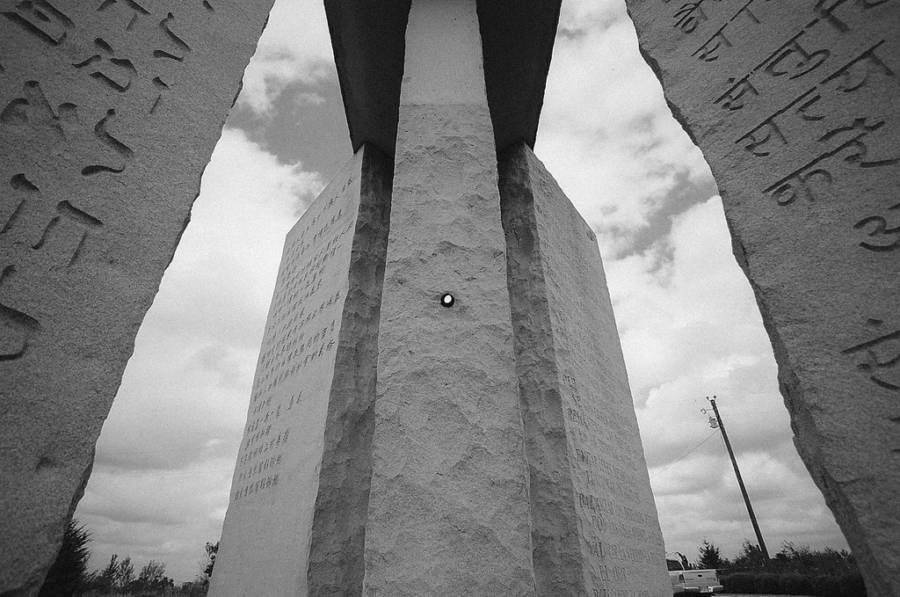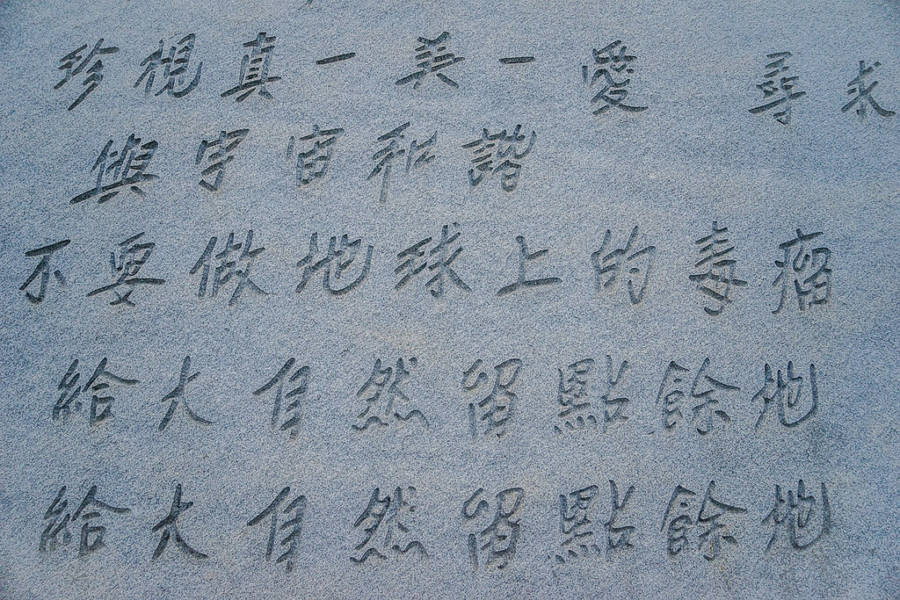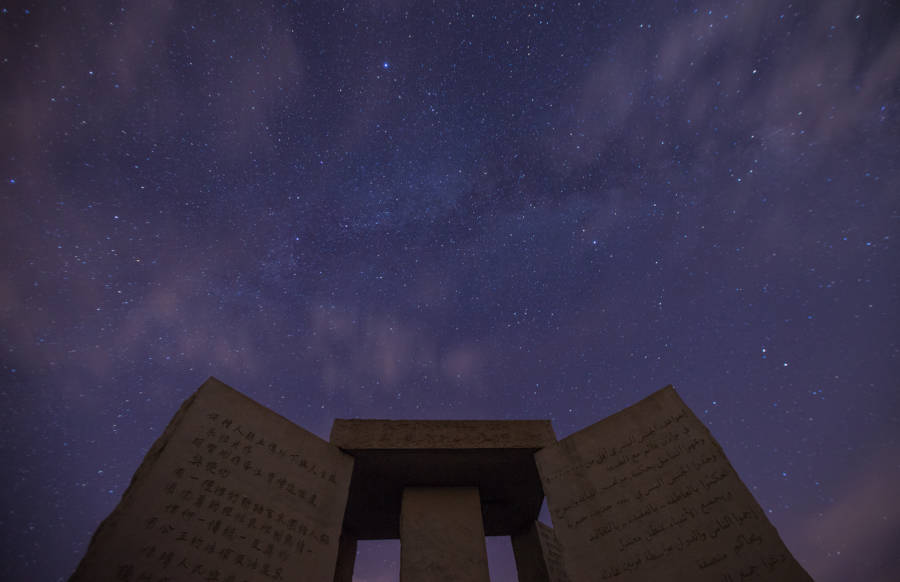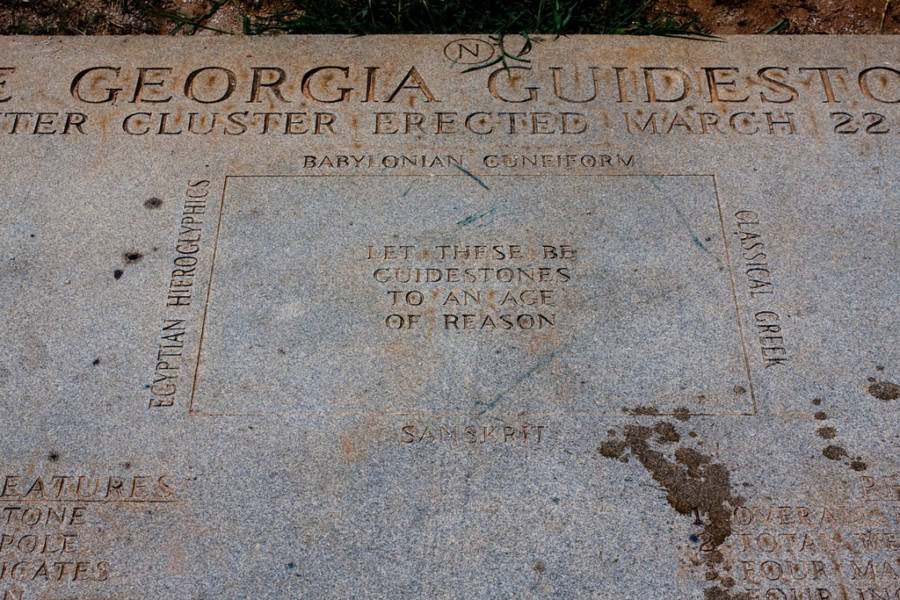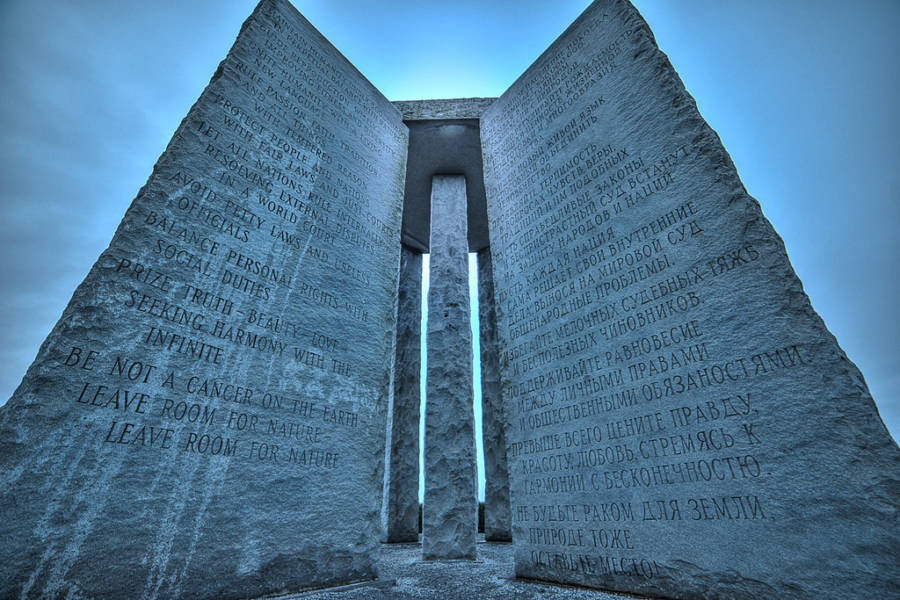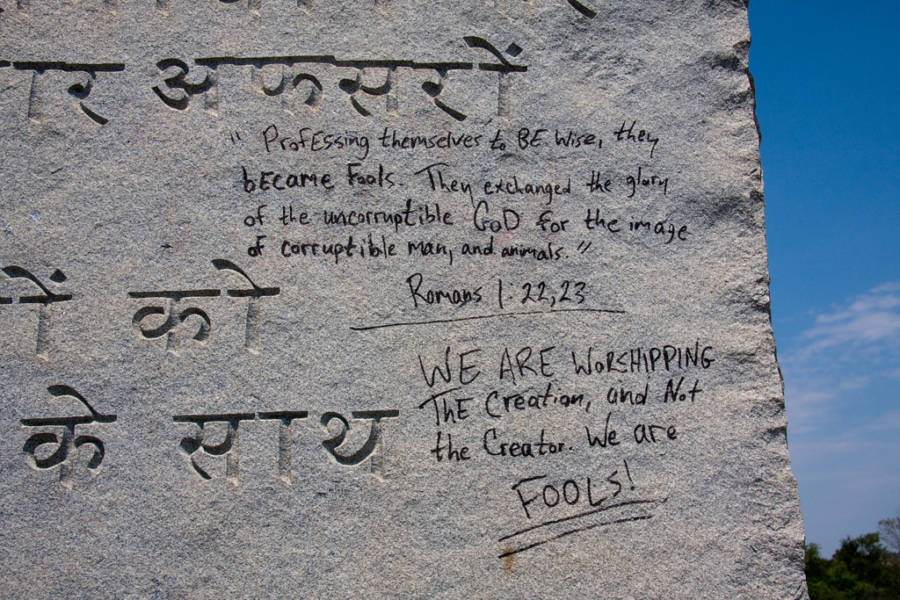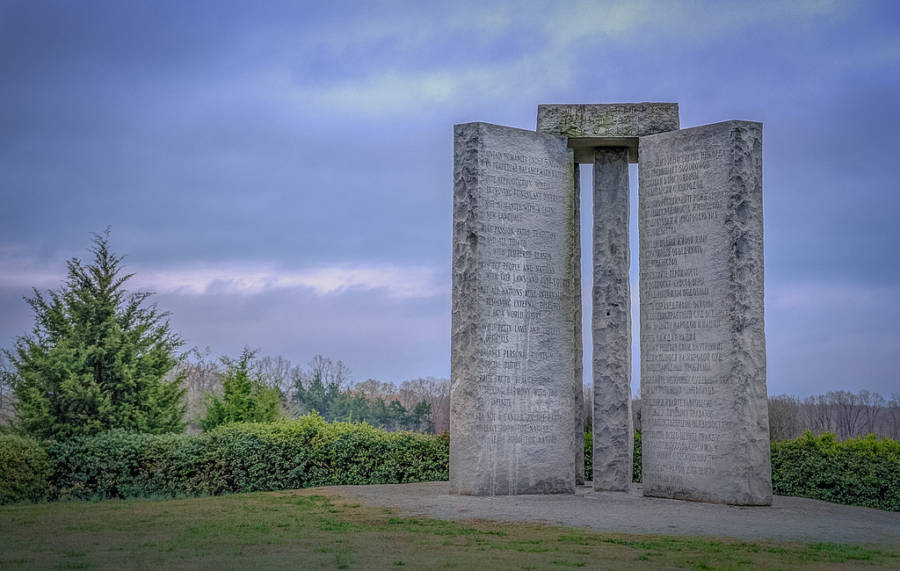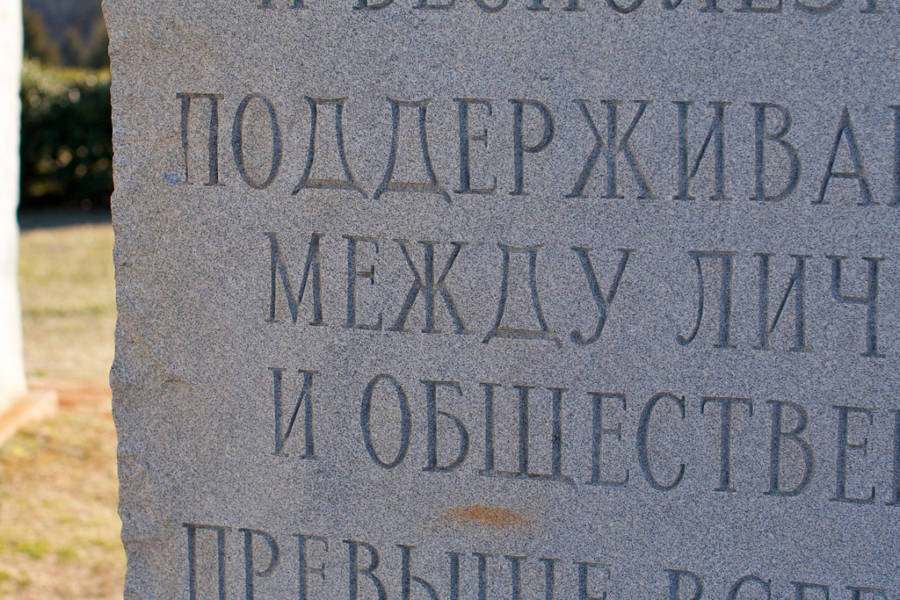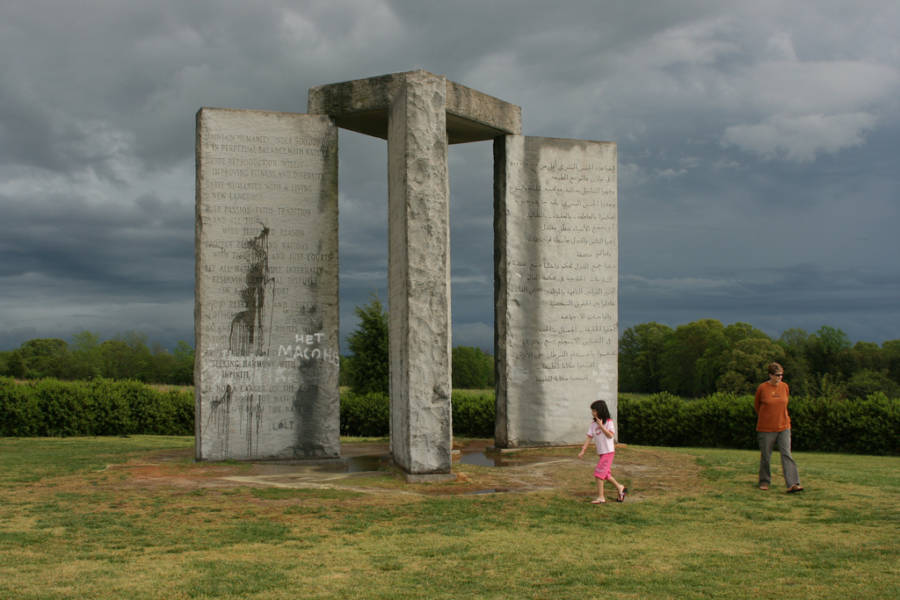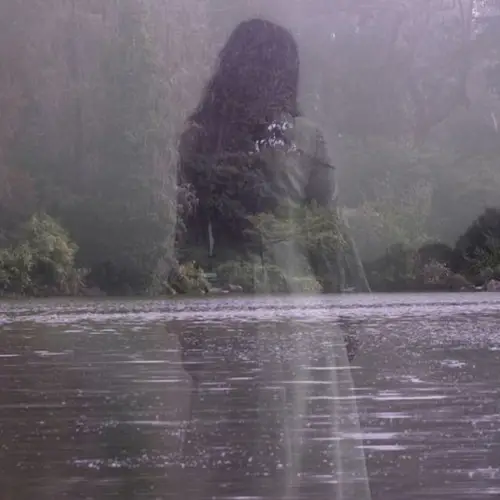Erected in 1980, the Georgia Guidestones monument served as both a solar calendar and a strange list of rules for a post-apocalyptic society to follow — and some people believed it was satanic.
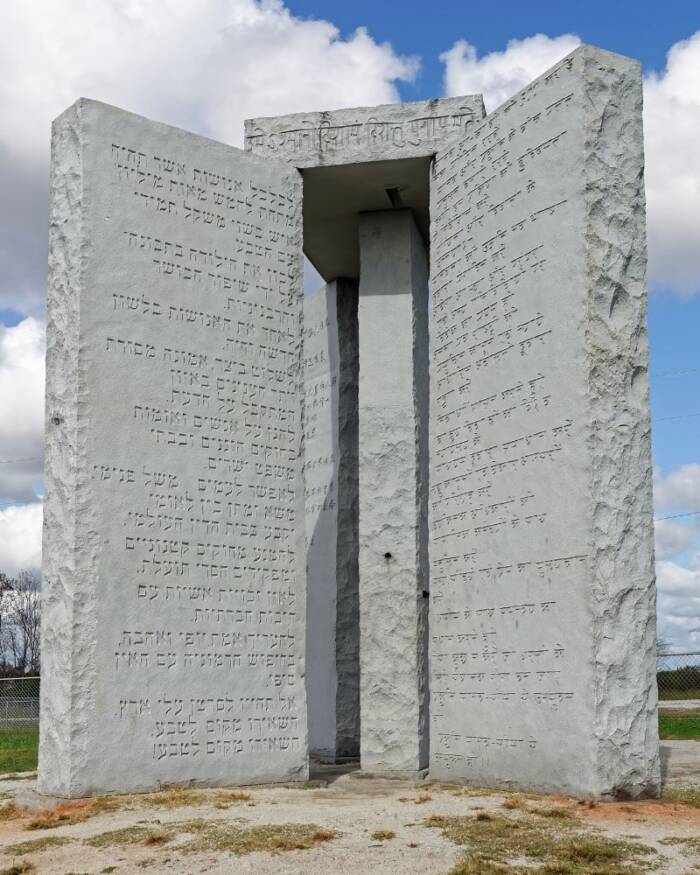
Judson McCranie/Wikimedia CommonsBefore the Georgia Guidestones were destroyed in 2022, the monument stood more than 19 feet tall.
Sometimes called “America’s Stonehenge,” the Georgia Guidestones are just as mysterious as their name suggests. These massive slabs arranged into a towering monument in rural Georgia confounded tourists for decades. What we do know about the origins of the Georgia Guidestones hardly makes the picture any clearer.
The man responsible for the project called himself Robert Christian. This wasn’t his real name, and only two people ever met him face-to-face: a granite finisher and a banker.
Christian commissioned the bizarre monument to serve as a guideline for future humans in a post-apocalyptic society. The slabs listed 10 “rules” in eight different languages, and they also contained several astrological features, such as a hole through which the North Star could be seen.
The Georgia Guidestones stood high on a rural hillside for 42 years — then an act of vandalism brought the mysterious structure crumbling down.
Robert Christian Commissions The Georgia Guidestones
Robert Christian walked into the offices of Elberton Granite Finishing Company in Elbert County, Georgia, in June 1979. He explained to the business's president, Joe Fendley, that he represented an anonymous group who had been secretly planning a stone monument for 20 years and that he'd come to Elbert because their quarries had the best granite on Earth.
Fendley soon found that Christian's plan befit such grand preparations. The mysterious man wanted the monument to consist of five upright outer stone slabs that would weigh more than 42,000 pounds each — about three times the weight of an elephant. These stones would encircle a center pillar that weighed nearly 21,000 pounds, and the whole thing would be topped with a capstone weighing just under 25,000 pounds.
Christian needed such stones, he explained, because they needed to withstand the end of the world. Human civilization was about to destroy itself, Christian believed, and his monument would provide instructions for whatever was left of humanity after the apocalypse.
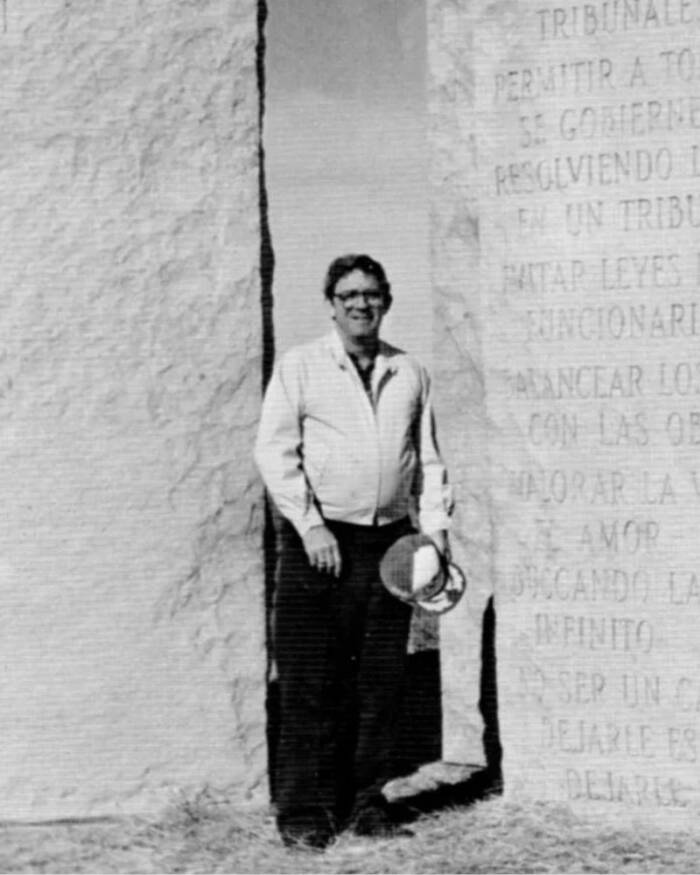
Elbert County Chamber of CommerceJoe Fendley with the Georgia Guidestones after the monument was completed in 1980.
"I was thinking, 'I got a nut in here now. How am I going [to] get him out?'" Fendley later said of that first meeting, according to a 2009 report from Wired. Fendley passed Christian along to local banker Wyatt Martin on the off chance that he might actually be able to produce the funds necessary for a project as enormous as the Georgia Guidestones, which cost over $100,000 in the end.
When Martin insisted that Christian provide his real name in order to keep the transaction above board, Christian had the banker sign a non-disclosure agreement and promise to destroy all the paperwork once the project was completed. Furthermore, Christian sent the money from a number of banks all across the country so that his origins couldn't be traced.
Martin and Fendley were skeptical, but sure enough, a $10,000 deposit soon arrived, and they set to work. Fendley found the stones and helped Christian secure a location for his monument. Once things were underway, Christian stopped by Fendley's office to say goodbye, adding, "You'll never see me again."
And he never did.
The Mysterious Monument Is Revealed
From then on, Christian communicated only with Martin — and only by mail. The letters came from cities all over the country and never from the same place twice.
Construction nevertheless carried on, and by March 1980, the Georgia Guidestones — standing more than 19 feet tall and weighing a staggering 240,000 pounds total — were ready to be unveiled.
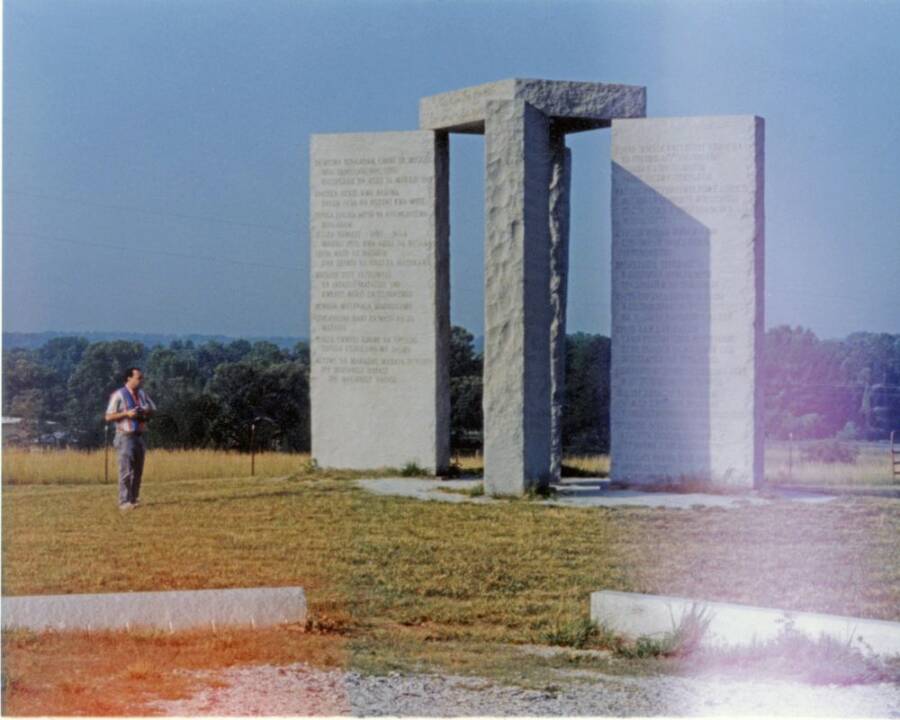
Richard Warren Lipack/Wikimedia CommonsHistorian Richard Warren Lipack visits the Georgia Guidestones in 1995.
The public would soon see that the monument was as strange as the man who commissioned it. Just as Christian specified, the Georgia Guidestones were engraved with a list of rules for humans in a post-apocalyptic world:
- 1. Maintain humanity under 500,000,000 in perpetual balance with nature.
2. Guide reproduction wisely — improving fitness and diversity.
3. Unite humanity with a living new language.
4. Rule passion — faith — tradition — and all things with tempered reason.
5. Protect people and nations with fair laws and just courts.
6. Let all nations rule internally resolving external disputes in a world court.
7. Avoid petty laws and useless officials.
8. Balance personal rights with social duties.
9. Prize truth — beauty — love — seeking harmony with the infinite.
10. Be not a cancer on the Earth — Leave room for nature — Leave room for nature.
These rules were written in eight languages: English, Spanish, Swahili, Hindi, Hebrew, Arabic, Chinese, and Russian.
Beyond these instructions, called "The 10 Commandments of the Antichrist" by opponents, the Georgia Guidestones featured astronomical specifications so particular that Fendley had to bring in an astronomer from the University of Georgia to help.
These included a hole through which the North Star would always be visible at night, a slot that aligned with the rising Sun on solstices and equinoxes, and a pinhole in the capstone through which the light shone in such a way each day at noon that it focused a sunbeam on the monument's center stone that showed what day of the year it was.
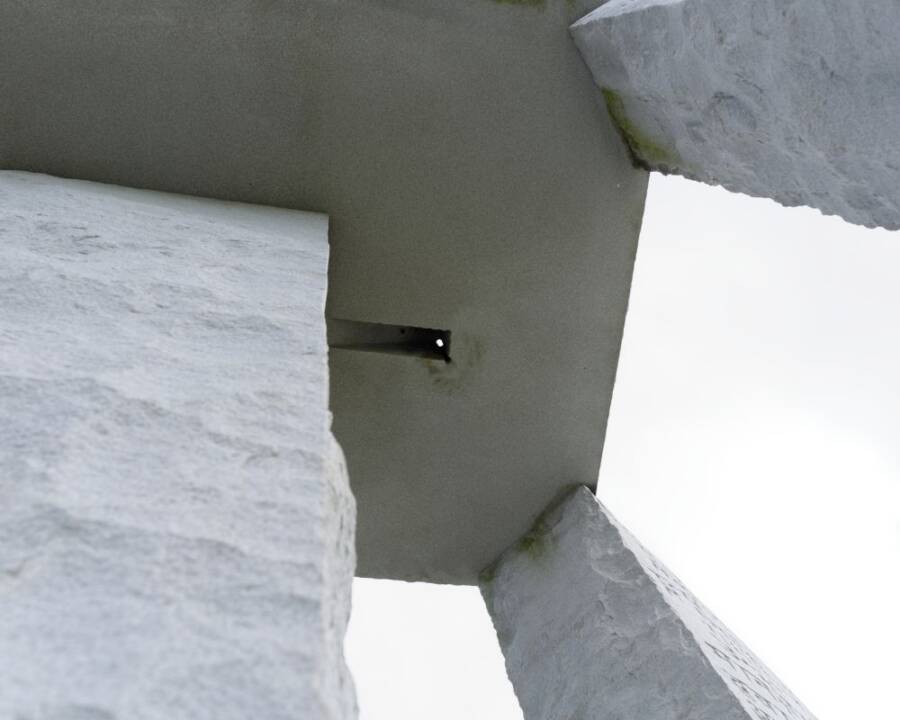
Wikimedia CommonsThis small hole in the capstone was positioned to channel sunlight onto the center pillar at noon each day. The spot where the sunbeam landed on the pillar showed which day of the year it was.
In addition to providing guidance to a post-apocalyptic society, Christian had wanted to make sure that the Georgia Guidestones could serve as a solar calendar, compass, and clock as well.
But why did Christian pay so much money to have the Georgia Guidestones constructed? And who was he?
Inside The Theories About Robert Christian's Identity
Speculation about Robert Christian's real identity has run rampant ever since the Georgia Guidestones were revealed. Some believe he was a religious fanatic; others say he was involved in the New World Order, a conspiracy theory that claims agents across the globe are working to establish a worldwide totalitarian government.
What we do know is that Robert Christian's name first appeared as an author for a book titled Common Sense Renewed. This book detailed Christian's many guidelines for a better world. In it, he wrote:
"I am the originator of the Georgia Guidestones and the sole author of its inscriptions. I have had the assistance of a number of other American citizens in bringing the monument into being. We have no mysterious purpose or ulterior motives. We seek common sense pathways to a peaceful world, without bias for particular creeds or philosophies. Yet our message is in some areas controversial. I have chosen to remain anonymous in order to avoid debate and contention. Our guides must stand on their own merits."
He detailed his ideas for political and economic testing for voters, creating population control policies, and providing healthcare on a preferential basis. While Christian's book laid out his philosophies clearly, it gave no clues as to his real identity.
Then, in 2015, a documentary about the Georgia Guidestones was released called Dark Clouds Over Elberton. The film's director, Christian J. Pinto, met with Wyatt Martin, the banker who was the sole keeper of Robert Christian's secret identity. With some convincing, Martin disclosed that he hadn't destroyed the documents as he had originally promised. They still remained locked in his basement.
The film crew managed to get their hands on the files and discovered that many of the letters Christian sent to Martin came from Fort Dodge, Iowa. With a little research, the crew surmised that the real identity of Robert Christian was Herbert H. Kersten.

Des Moines RegisterA photo of Herbert Kersten in the Oct. 11, 1987 edition of the Des Moines Register.
Kersten was an elderly physician who wrote letters to newspapers that were strikingly similar to the writing in Christian's book.
For instance, on Jan. 25, 1981, Kersten wrote to the Des Moines Register:
"Most important of all, America should now begin to direct the attention of the world to solving the fundamental problem which threatens to engulf all humanity in social and economic catastrophe. I refer to the uncontrolled reproduction of our species, which has already caused human numbers to far exceed the level which our planet can support in decency."
Unfortunately, Kersten passed away in 2005, and his living family members have denied his involvement with the Georgia Guidestones. However, Robert Christian's true identity isn't the only conspiracy surrounding his monument.
Controversy, Conspiracy, And Vandalism At The Georgia Guidestones
Although Robert Christian made his intentions clear, that hasn't stopped conspiracy theorists from speculating about the real meaning behind his monument. Some believe that the Georgia Guidestones might actually be a landing site for alien visitors, an edict of the New World Order set on controlling the populace through genocide, or a giant monument to Satan.
In 2022, Kandiss Taylor, a gubernatorial candidate in Georgia, declared that the Guidestones were satanic and that her first job as governor would be to destroy them. On her official website, she wrote, "On my first day as Governor of Georgia, I will move to DEMOLISH the Demonic plans of our enemy. The Satanic agenda is NOT welcome in our state. Support my fight by contributing, and watch as I turn the Georgia Guidestones into dust!"
Other figures like Alex Jones, an American radio host known for his far-out claims, stated that the Illuminati controlled the stones and that they stood as a reinforcement for eugenics.
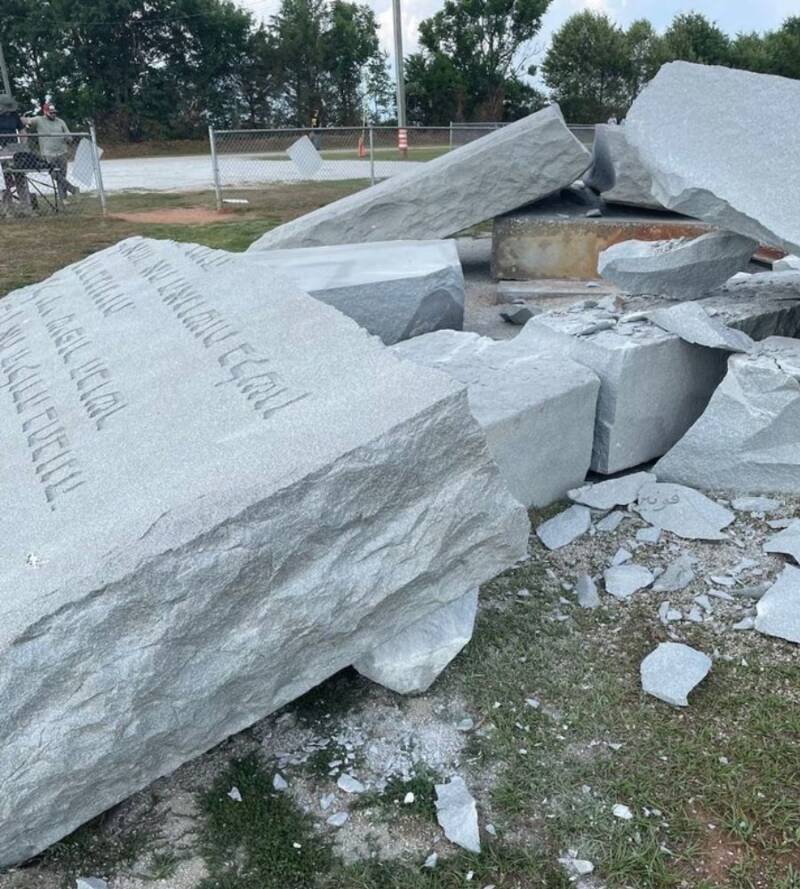
Georgia Bureau of InvestigationThe explosion in July 2022 crumbled one of the four outer slabs, rendering the entire monument unstable.
Amid all the speculation, Christian never re-emerged to correct anyone, although he did stay in touch with Martin over the years, even meeting him for dinner several times. Still, Christian never revealed anything further about the Georgia Guidestones.
As Christian always said, according to Martin, "If you want to keep people interested, you can let them know only so much."
The conspiracy theories permeated so many conversations around the Georgia Guidestones that locals believe the rumors were responsible for their destruction.
On July 6, 2022, security cameras captured an explosion at the site:
The force of it destroyed one slab of granite and rendered the entire monument unstable. The footage also showed a silver car speeding from the scene, although no arrests were ever made.
Workers later completely dismantled the Georgia Guidestones due to safety concerns.
"My initial reaction was heartbreak and anger, frustration," Daniel Graves, the mayor of Elberton, told NPR at the time. "And I think that's consistent with the community's reaction."
Experts in extremism state that the destruction of the Georgia Guidestones, once a beloved landmark, is a perfect example of the dangers of conspiracy theories. Jared Holt, a researcher with the Institute for Strategic Dialogue, told NPR, "Whether it's elected officials appealing to online conspiracists or online conspiracists trying to become elected officials, we're really starting to see the effects of that in clear and obvious ways."
The remaining pieces of the Georgia Guidestones are currently on display at the Elberton Granite Museum for visitors interested in one of Georgia's biggest mysteries.
After this look at the Georgia Guidestones, discover the mysteries of crop circles. Then, check out five bizarre structures and findings uncovered by Google Earth.
